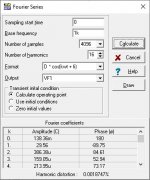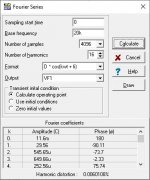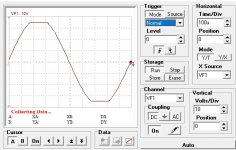I know there is always a bigger fish in the Sea.
It is always interesting to see and discover new topology
and methods for lower distortion.
Its not for heated discussion.
Maybe a reason for self honesty.
When is Enough, Enough ? As far as actual needed distortion?
Assuming the actual original source of the music has higher distortion.
And even very well built speakers have higher distortion.
.001 Distortion a reasonable number to say.. it is good enough?
Understanding of course seeing a better number when designing
is exciting and something to be proud of.
But what is the threshold between the number game, and what
is actually realistically needed.
Anyways, playing around with somewhat typical Class AB amplifier.
This is a design of mine below.
I just found using common high quality transistors.
Using Feedback current sources.
Then Basically keeping the second gain stage simple eliminates rail stick.
And Using a basic current mirror and boosting up the LTP current higher
than usual. Around 6ma
Seems to hold up rather well for distortion.
R3 and C2 seem to be the real magic,
this network seems to make the
amplifier rather stable, and allows C7 to remain rather low. Which seems
to defy a majority of possible THD at High Frequency.
.001 % Distortion @ 1 kHz
.006 % Distortion @ 20 kHz




It is always interesting to see and discover new topology
and methods for lower distortion.
Its not for heated discussion.
Maybe a reason for self honesty.
When is Enough, Enough ? As far as actual needed distortion?
Assuming the actual original source of the music has higher distortion.
And even very well built speakers have higher distortion.
.001 Distortion a reasonable number to say.. it is good enough?
Understanding of course seeing a better number when designing
is exciting and something to be proud of.
But what is the threshold between the number game, and what
is actually realistically needed.
Anyways, playing around with somewhat typical Class AB amplifier.
This is a design of mine below.
I just found using common high quality transistors.
Using Feedback current sources.
Then Basically keeping the second gain stage simple eliminates rail stick.
And Using a basic current mirror and boosting up the LTP current higher
than usual. Around 6ma
Seems to hold up rather well for distortion.
R3 and C2 seem to be the real magic,
this network seems to make the
amplifier rather stable, and allows C7 to remain rather low. Which seems
to defy a majority of possible THD at High Frequency.
.001 % Distortion @ 1 kHz
.006 % Distortion @ 20 kHz
Attachments
Last edited:
"R3 and C2 seem to be the real magic, this network seems to make the
amplifier rather stable, and allows C7 to remain rather low. "
Very old stability circuit from the 50s, and is in many tube amplifiers.
amplifier rather stable, and allows C7 to remain rather low. "
Very old stability circuit from the 50s, and is in many tube amplifiers.
I still have a push-pull tube amp. I guess 0.5% THD? Not a problem.
BTW, R4 and R5 eat too much voltage, which may effect T4 working conditions. You may consider using smaller value.
BTW, R4 and R5 eat too much voltage, which may effect T4 working conditions. You may consider using smaller value.
It depends a good amount on the fundamental frequency in question, its amplitude and what harmonics are added. Other factors include beats and ambient noise, headset or loudspeakers, not to mention individual subjects. It’s never been as simple as “distortion below 1% is inaudible”, although that one is still touted by AES papers and other groups.
I do not care to achieve lowest distortion. My priority is to make optimal design with topology that I choose. I love to try many topology. I can make it simple or make it more complicated, it depend on my mood 😀
I like to achieve good harmonic profile of the distortion like monotonic than lowest distortion. Monotonic harmonic profile easy to achieve with class A amplifier. But with class AB it difficult, especially at high frequency.
In my experience, amplifier with low distortion will sound good at good speaker and good recording. Sometime the higher distortion of amplifier will sound better at average speaker (or mediocre) but depend on harmonic profile of the distortion. Distortion is not always sound bad, it can sound pleasing like effect box.
I like to achieve good harmonic profile of the distortion like monotonic than lowest distortion. Monotonic harmonic profile easy to achieve with class A amplifier. But with class AB it difficult, especially at high frequency.
In my experience, amplifier with low distortion will sound good at good speaker and good recording. Sometime the higher distortion of amplifier will sound better at average speaker (or mediocre) but depend on harmonic profile of the distortion. Distortion is not always sound bad, it can sound pleasing like effect box.
.001 Distortion a reasonable number to say.. it is good enough?
The human ear, while having different aural capabilities in every person, can actually only detect distortion (in music) down to a certain point.
This further depends on the source quality, speaker quality, room acoustics, and yes, amplifier capability.
No human can detect amplifier distortion in the ".006" range, I don't care who wants to argue that point with me.
Mcintosh vintage equipment, while being highly touted, endeared, and sought after, usually hovered in the .25% distortion range, and not detectable, yet it doesn't stop them from wanting it.
That's just brand preference, status value, but I leave that for another discussion.
I've heard amps with 1%+ distortion levels, and they didn't bother my enjoyment of them.
So discussing something literally impossible to detect is essentually a moot point.
WhiteDragon, ideally the distortion of the whole audio chain from microphone to loudspeaker should be inaudible, and it makes sense to give only a small part of the whole-chain distortion budget to the amplifier. Even then the figures you mentioned should be more than good enough.
Whether you actually get those distortion levels in real life is a different matter. It depends a lot on the layout, for example; you will have to keep the coupling from the currents through the output transistors to the input and the output small.
Whether you actually get those distortion levels in real life is a different matter. It depends a lot on the layout, for example; you will have to keep the coupling from the currents through the output transistors to the input and the output small.
Last edited:
Yeah I have definitely heard amplifiers with more distortion.
Ironically those numbers are still behind the decimal point.
So reality is its still 0 distortion.
Having heard .02% or even .7% amplifiers.
I dont remember it having a negative effect on the experience.
Ironically with some extremely slow power transistors.
The distortion using this amplifier front end is still good.
Sometimes maybe some big old TO3 transistor cans and huge heatsinks.
Is impressive as well. Than raw numbers on paper
Luckily or maybe Unluckily have also designed circuits specifically to make distortion.
And after a lot of time playing with those topologies
It is interesting as well to actually hear the difference between a odd ordered or even ordered distortion.
And even then
There is actually benefits with Even or Odd order distortion.
And most the real magic in " Good" distortion was filters.
To make the distortion work for the bandwidth of the instrument
or source coming through.
Otherwise as far as non audible...but " audible" magic 2nd harmonic for
HiFi. I think its the only other area I care to look at for designs.
Anyways, I love to see and explore all kinds of amplifier topologys out there.
And either simulate or build them.
Lately I just keep coming back to this basic design of mine.
I was a little obsessed for awhile with .0001% or better amplifiers
Then after the complexity and stability issues and parts count.
Just lost interest.
Ironically those numbers are still behind the decimal point.
So reality is its still 0 distortion.
Having heard .02% or even .7% amplifiers.
I dont remember it having a negative effect on the experience.
Ironically with some extremely slow power transistors.
The distortion using this amplifier front end is still good.
Sometimes maybe some big old TO3 transistor cans and huge heatsinks.
Is impressive as well. Than raw numbers on paper
Luckily or maybe Unluckily have also designed circuits specifically to make distortion.
And after a lot of time playing with those topologies
It is interesting as well to actually hear the difference between a odd ordered or even ordered distortion.
And even then
There is actually benefits with Even or Odd order distortion.
And most the real magic in " Good" distortion was filters.
To make the distortion work for the bandwidth of the instrument
or source coming through.
Otherwise as far as non audible...but " audible" magic 2nd harmonic for
HiFi. I think its the only other area I care to look at for designs.
Anyways, I love to see and explore all kinds of amplifier topologys out there.
And either simulate or build them.
Lately I just keep coming back to this basic design of mine.
I was a little obsessed for awhile with .0001% or better amplifiers
Then after the complexity and stability issues and parts count.
Just lost interest.
WhiteDragon, ideally the distortion of the whole audio chain from microphone to loudspeaker should be inaudible, and it makes sense to give only a small part of the whole-chain distortion budget to the amplifier. Even then the figures you mentioned should be more than good enough.
Whether you actually get those distortion levels in real life is a different matter. It depends a lot on the layout, for example; you will have to keep the coupling from the currents through the output transistors to the input and the output small.
Good point.
Since of course a model wont show these issues.
I have done a series or torture test in simulation for stability.
But assume real life is different
Something I have been doing a bit of research on. And curious on any further additions which should be made. For current coupling
Asides from assuming the usually 10 ohm resistor and diodes or loop breaker for the input. And likewise a few more resistors and capacitors on the input for radio interference.
Hi WhiteDragon,
You are oversimplifying by putting a single THD figure on an amplifier.
The THD figure for audibility of amplifier nonlinear distortions changes depending on the harmonic structure of the distortion. The harmonic structure changes with amplifier output power and your speaker SPL, Therefore your speaker sensitivity affects how low the THD of your amp needs to be inaudible!
If an amp (or speaker) produces all 2nd harmonic for example then a THD of 1% or less is inaudible to the majority of people (about 99 in 100).
But if (hypothetically) your amp produces a 60th harmonic of a 50Hz fundamental then the level of that harmonic needs to be less than 0.0001% to be inaudible.
This wide range of THD audibility levels have been known for quite a while now. They are used for designing ADC/DACs and MP3 algorithms and loudspeakers, eg Fielder, JAES, July 1987, p517-534 and a summary plot is below:

This plot is from Linear Audio Volume 4 based on Fielder's data volumes | Linear Audio and I discuss it here and here.
Assuming that's the only harmonic then the THD for the absolutely most sensitive point is when the harmonic at 3.5kHz and the SPL is 110dB and then the THD needs to be just below 0.00003% to be inaudible.
For crossover distortion higher harmonics usually fall away fast enough above the 20th that we do not need to go below 0.01% to be confident that we cannot hear crossover distortion. An example of distortion in the 3kHz range being heard at such extremely low levels is a voicecoil rubbing on the poles.
You are oversimplifying by putting a single THD figure on an amplifier.
The THD figure for audibility of amplifier nonlinear distortions changes depending on the harmonic structure of the distortion. The harmonic structure changes with amplifier output power and your speaker SPL, Therefore your speaker sensitivity affects how low the THD of your amp needs to be inaudible!
If an amp (or speaker) produces all 2nd harmonic for example then a THD of 1% or less is inaudible to the majority of people (about 99 in 100).
But if (hypothetically) your amp produces a 60th harmonic of a 50Hz fundamental then the level of that harmonic needs to be less than 0.0001% to be inaudible.
This wide range of THD audibility levels have been known for quite a while now. They are used for designing ADC/DACs and MP3 algorithms and loudspeakers, eg Fielder, JAES, July 1987, p517-534 and a summary plot is below:
This plot is from Linear Audio Volume 4 based on Fielder's data volumes | Linear Audio and I discuss it here and here.
Assuming that's the only harmonic then the THD for the absolutely most sensitive point is when the harmonic at 3.5kHz and the SPL is 110dB and then the THD needs to be just below 0.00003% to be inaudible.
For crossover distortion higher harmonics usually fall away fast enough above the 20th that we do not need to go below 0.01% to be confident that we cannot hear crossover distortion. An example of distortion in the 3kHz range being heard at such extremely low levels is a voicecoil rubbing on the poles.
Attachments
After a certain point, chasing for more zeroes to the right of the decimal point on a distortion figure before the first non zero number is encountered is pointless if this is done for audio purposes. For laboratory test & measurement equipment, it can be a worthy goal in some settings.
- Home
- Amplifiers
- Solid State
- When is Enough, Enough? Class AB .001% Distortion




